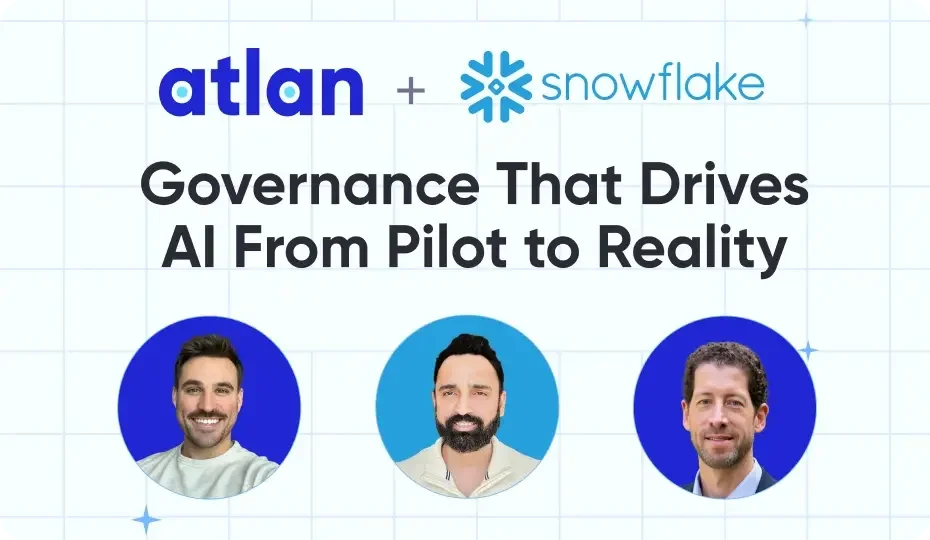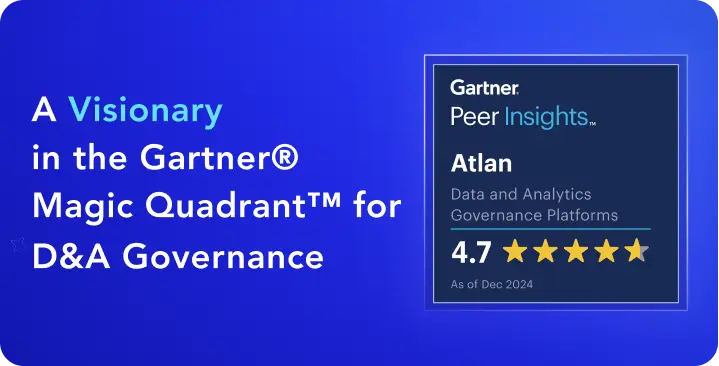Agile Data Governance Model: Concept, Importance, Components, and Best Practices

Share this article
You may have heard the word “agile” connected to software development. But did you know it’s also a successful model for data governance?
In this article, we’ll cover the tenets of an agile data governance model, how to identify when you need it, and the components of a successful agile data governance framework.
Table of contents #
- What is agile data governance?
- What is an agile data governance model?
- 3 signs you need an agile data governance model
- What makes an agile data governance model successful?
- Components of an agile data governance model
- Bottomline
- Agile data governance model: Related Reads
What is agile data governance? #
The agile methodology has been used in software development for years, where it emphasizes delivering results quickly and demonstrating flexibility in the face of changing requirements.
An agile approach to data governance works similarly. In agile data governance, small teams spearhead bottoms-up data initiatives within a framework that enforces security, quality, and compliance.
What is an agile data governance model? #
An agile data governance model defines a framework of people, processes, and tools that enables an agile data governance vision.
In practice, this means that people - individuals and teams - work with a defined set of tools and processes that enable bottom-up data projects to succeed.
What would such an organization look like?
In an organization that incorporated the agile data governance model, employees have the ability to find and publish data across the company. They can also successfully classify and track assets, and manage security.
What’s more, employees can do all of this without enduring lengthy corporate sign-off processes or making special requests to their data engineering teams.
An agile data governance model provides several tangible benefits, including faster time to realize value from projects, faster time to market for data projects, and better collaboration and less friction between teams.
Another huge benefit? Your data governance initiative is less likely to fail. Gartner estimates that 80% of all organizations seeking to scale their digital business through 2025 will fail due to relying on old, non-agile approaches to governance.
3 signs you need an agile data governance model #
The old, top-down approach to data governance typically means that many data projects remain mired in red tape and resource constraints.
A few signs that your organization could benefit from an agile data governance model include:
- Users can’t find the data they need
- IT is a bottleneck to data projects
- No visibility into downstream impact
Let’s look into the nuances of each sign.
1. Users can’t find the data they need #
At too many companies, there’s no central place to locate and verify the veracity of data. Data remains locked in silos - team- or department-specific data stores built to serve one specific purpose.
Even if users can find such data, in many cases, they’re not confident that they can use it. The data may be riddled with quality issues, or be so out of date that using it to drive business decisions is not only difficult but dangerous.
2. IT is a bottleneck to data projects #
When users can’t find or readily query the data they need, their project usually translates into an ask on their IT and data engineering teams. But technical teams only have so many resources available at once.
One research report in 2021 found many IT departments had backlogs stretching back from three months to a full year. Ironically, one of the biggest culprits in such delays was not being able to find the right data to drive the project.
3. No visibility into downstream impact #
Can your team change the data type of a column in one of its data stores? If you can’t trace the lineage of your data, you have no way of knowing whether this change will break reports and other data consumers who depend on you.
The result? Your business can’t adapt to changing needs and circumstances. You remain stuck in the past, afraid to make necessary changes.
What makes an agile data governance model successful? #
Echoing Gartner’s findings above, the Data for Business Performance Institute says that 84% of digital transformation projects fail. Such stats underscore the need for a community-centric approach to data governance that’s flexible and realistic.
A successful agile data governance framework is built around a few core principles, such as:
- Enabling collaboration: Users can freely work together on sourcing, classifying, and altering data to meet their needs.
- Bringing flexibility to data projects: Teams can respond to changing business initiatives, technologies, processes, and economic conditions without rebuilding systems from scratch.
- Empowering users: Users can make decisions themselves about the best way to manage data, as the organization gives them the tools and frameworks to do so in a safe and compliant manner.
- Delivering measurable results: You should be able to define Key Performance Indicators (KPIs) and metrics that validate your model and show substantive improvements over the Old Way of doing business.
Components of an agile data governance model #
So, how do you put an agile data governance model into practice? Here’s a breakdown of the key components you’ll need to get started:
- Data governance framework
- Automation
- Collaboration framework
- Metrics
- Training and support
Keep in mind that your agile data governance process should, itself, be agile. You’ll never “finish” any of these components. Rather, you should use experience - your successes and failures - to alter and refine these over time.
Now let’s explore each agile data governance model component further.
Data governance framework #
A data governance framework defines the standards, protocols, and tools for effectively managing data across an organization. With a framework in place, users have the confidence that they can manage their own data in a secure and compliant fashion.
A successful data governance framework should have buy-in from stakeholders across the company - especially from senior leadership. It should further define the features and capabilities that all users will leverage to share data across the company.
The technological center of an agile data governance framework is a data catalog. Data catalogs operate as a central clearinghouse for an organization’s data. They also expose features that make data governance easier, including:
- Personalized, role-based access control for security
- Active metadata to describe the data, its ownership, and its purpose
- Data lineage to verify the veracity of data and assess the downstream impact of changes
- Data classification and data quality controls
- Column-level lineage that’s intuitive, visual, and actionable
- Business glossaries to define commonly used business terms and data points
Automation #
One reason traditional data governance strategies fail is that they’re bogged down in manual processes.
For example, figuring out if a user’s data exists elsewhere in the company in response to a GDPR right-to-erasure request may involve someone performing manual searches of numerous data stores.
With a data catalog in place, many key compliance and regulatory requirements can be implemented and enforced through intelligent automation.
A data catalog, for example, can flag when some data doesn’t have a GDPR data classification tag. Or detect when a data field doesn’t conform to formatting requirements set out by the organization.
Automation can also ensure that data remains up to date via active metadata support. Active metadata uses open APIs to connect all of your data stack’s tools into a bidirectional stream, ensuring everything remains synchronized and current.
The data catalog space is experimenting with even more advanced types of automation. AI support, for example, can assist data analysts in generating complex SQL queries or help data stewards in auto-documenting the data assets they own.
Collaboration framework #
A tool like a data catalog isn’t any good if people don’t use it. One of the best ways to ensure adoption is by bringing the data catalog into the tools that users already use to collaborate, such as Slack and Jira.
Embedded collaboration enables tying critical discussions back to their data assets so that they’re preserved for future reference. One example is linking a Slack discussion about the field in a table back to the field’s definition and description in your data catalog.
Metrics #
Accurate measurements are critical in determining whether your agile data governance model is delivering results.
Key performance indicators (KPIs) for data projects can include things such as the number of data projects successfully completed in the past quarter, or the number of data assets that have verified classifications.
You can also define data quality metrics to measure the accuracy, completeness, validity, and timeliness of your data.
Training and support #
No one will use a data catalog if they don’t know why they should use it or how to get the results they want. An ongoing training and support program is vital to the success of an agile data governance model.
A data catalog training program does more than just show users how to use a tool. It also helps them understand the entire data governance framework, so that they understand how to make safe, intelligent, and compliant decisions around data.
Bottomline #
The majority of data transformation projects fail, but they don’t have to. By shifting from a top-down data governance regime to an agile data governance model, you can give your users the tools and processes they need to make smarter decisions with data.
Need a data catalog to get started with your agile data governance journey? Consider getting hands-on with Atlan.
Agile data governance model: Related Reads #
- What is Data Governance? Its Importance, Principles & How to Get Started?
- Key Objectives of Data Governance : How Should You Think About Them?
- Data Governance Framework — Examples, Templates, Standards, Best Practices & How to Create One?
- Data Governance and Compliance: Act of Checks & Balances
- How to implement data governance? Steps, Prerequisites, Essential Factors & Business Case
- How to Improve Data Governance? Steps, Tips & Template
- 7 Steps to Simplify Data Governance for Your Entire Organization
- Snowflake Data Governance — Features, Frameworks & Best Practices
- Automated Data Governance : How Does It Help You Manage Access, Security & More at Scale?
- Enterprise Data Governance — Basics, Strategy, Key Challenges, Benefits & Best Practices
Share this article











